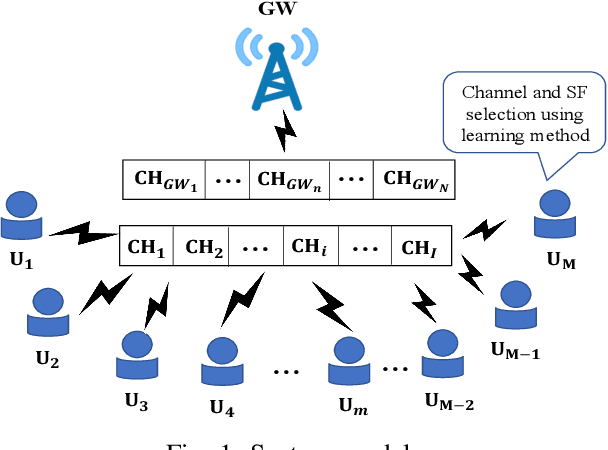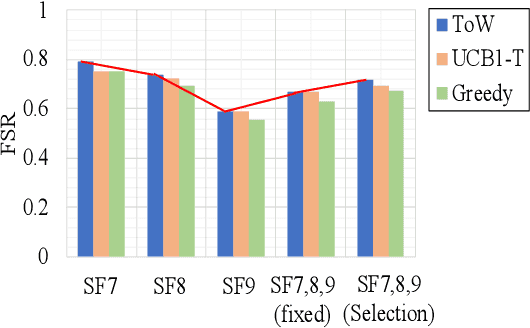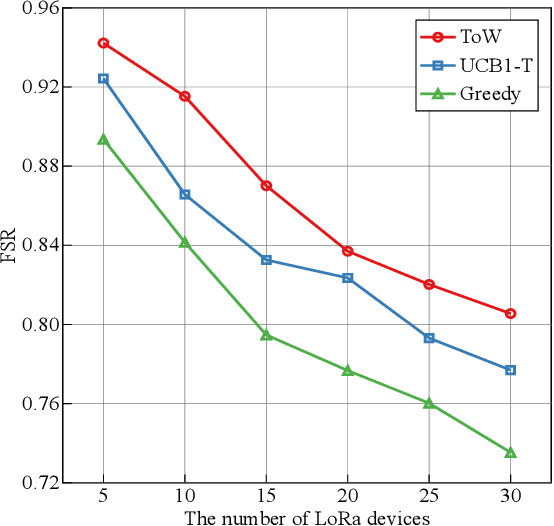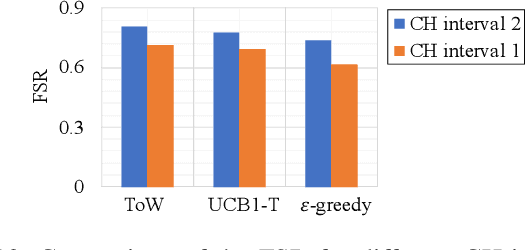Aohan Li
Energy Efficient Transmission Parameters Selection Method Using Reinforcement Learning in Distributed LoRa Networks
Oct 15, 2024



Abstract:With the increase in demand for Internet of Things (IoT) applications, the number of IoT devices has drastically grown, making spectrum resources seriously insufficient. Transmission collisions and retransmissions increase power consumption. Therefore, even in long-range (LoRa) networks, selecting appropriate transmission parameters, such as channel and transmission power, is essential to improve energy efficiency. However, due to the limited computational ability and memory, traditional transmission parameter selection methods for LoRa networks are challenging to implement on LoRa devices. To solve this problem, a distributed reinforcement learning-based channel and transmission power selection method is proposed, which can be implemented on the LoRa devices to improve energy efficiency in this paper. Specifically, the channel and transmission power selection problem in LoRa networks is first mapped to the multi-armed-bandit (MAB) problem. Then, an MAB-based method is introduced to solve the formulated transmission parameter selection problem based on the acknowledgment (ACK) packet and the power consumption for data transmission of the LoRa device. The performance of the proposed method is evaluated by the constructed actual LoRa network. Experimental results show that the proposed method performs better than fixed assignment, adaptive data rate low-complexity (ADR-Lite), and $\epsilon$-greedy-based methods in terms of both transmission success rate and energy efficiency.
Adaptive Learning of Consistency and Inconsistency Information for Fake News Detection
Aug 15, 2024



Abstract:The rapid advancement of social media platforms has significantly reduced the cost of information dissemination, yet it has also led to a proliferation of fake news, posing a threat to societal trust and credibility. Most of fake news detection research focused on integrating text and image information to represent the consistency of multiple modes in news content, while paying less attention to inconsistent information. Besides, existing methods that leveraged inconsistent information often caused one mode overshadowing another, leading to ineffective use of inconsistent clue. To address these issues, we propose an adaptive multi-modal feature fusion network (MFF-Net). Inspired by human judgment processes for determining truth and falsity in news, MFF-Net focuses on inconsistent parts when news content is generally consistent and consistent parts when it is generally inconsistent. Specifically, MFF-Net extracts semantic and global features from images and texts respectively, and learns consistency information between modes through a multiple feature fusion module. To deal with the problem of modal information being easily masked, we design a single modal feature filtering strategy to capture inconsistent information from corresponding modes separately. Finally, similarity scores are calculated based on global features with adaptive adjustments made to achieve weighted fusion of consistent and inconsistent features. Extensive experimental results demonstrate that MFF-Net outperforms state-of-the-art methods across three public news datasets derived from real social medias.
A Lightweight Transmission Parameter Selection Scheme Using Reinforcement Learning for LoRaWAN
Aug 03, 2022



Abstract:The number of IoT devices is predicted to reach 125 billion by 2023. The growth of IoT devices will intensify the collisions between devices, degrading communication performance. Selecting appropriate transmission parameters, such as channel and spreading factor (SF), can effectively reduce the collisions between long-range (LoRa) devices. However, most of the schemes proposed in the current literature are not easy to implement on an IoT device with limited computational complexity and memory. To solve this issue, we propose a lightweight transmission-parameter selection scheme, i.e., a joint channel and SF selection scheme using reinforcement learning for low-power wide area networking (LoRaWAN). In the proposed scheme, appropriate transmission parameters can be selected by simple four arithmetic operations using only Acknowledge (ACK) information. Additionally, we theoretically analyze the computational complexity and memory requirement of our proposed scheme, which verified that our proposed scheme could select transmission parameters with extremely low computational complexity and memory requirement. Moreover, a large number of experiments were implemented on the LoRa devices in the real world to evaluate the effectiveness of our proposed scheme. The experimental results demonstrate the following main phenomena. (1) Compared to other lightweight transmission-parameter selection schemes, collisions between LoRa devices can be efficiently avoided by our proposed scheme in LoRaWAN irrespective of changes in the available channels. (2) The frame success rate (FSR) can be improved by selecting access channels and using SFs as opposed to only selecting access channels. (3) Since interference exists between adjacent channels, FSR and fairness can be improved by increasing the interval of adjacent available channels.
 Add to Chrome
Add to Chrome Add to Firefox
Add to Firefox Add to Edge
Add to Edge